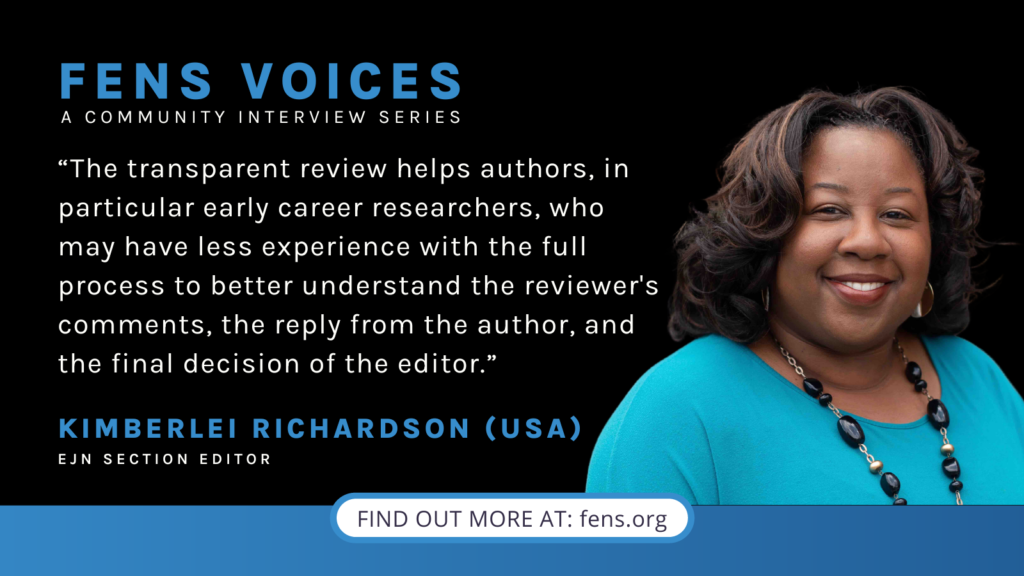
FENS Voices | If you can see it, then you can be it
03 March 2023
FENS News, Neuroscience News
As a new section editor for the European Journal of Neuroscience (EJN), the official journal of FENS, Dr Kimberlei Richardson (US) plays a critical role in supporting the neuroscience community in disseminating rigorous, peer-reviewed discovery research on the brain and central nervous system. Dr Richardson is an Associate Professor in the Department of Pharmacology at Howard University College of Medicine, and has received numerous awards including the RCMI Faculty Scholars award, Grass Foundation Fellowship and the American Psychological Association Neuroscience Fellowship. She has also received grants from the National Science Foundation (NSF), the National Institutes of Health (NIH), the Charles and Mary Latham Foundation, the Center for Hemoglobin Research in Minorities and the Howard University College of Medicine-Bridge Grant Program. Her publications include several scientific articles related to neural control of motivated behaviours and she has served as a scientific editor for two journal volumes focused on the neurobiology of addictive disorders and animal models of addictions to controlled substances. In addition to her research duties, Dr Richardson is devoted to increasing the number of underrepresented minorities in biomedical research. FENS Voices was excited to catch up with this inspirational new member of our community, and learn more about her scientific journey and research interests. Read the full interview below.

Q1: What sparked your passion for medicine/science?
KR: I was very fortunate to be a student in public elementary, middle and high schools that promoted and encouraged research through participation in science fairs. One of my first science projects in elementary school was to build an incubator. I recall the immense pride of creating an environment to successfully hatch a chicken egg. As a freshman in high school, I was afforded the opportunity to conduct research at the college level. I met Dr Bettye Jones who graciously opened her laboratories to me at Morehouse College and Morris Brown College. I was able to develop different phases of the project, investigating the impact of actinomycin D on the processes that contribute to the ability of black planaria to regenerate tissue. I spent my entire high school tenure working with Dr Jones and her research personnel and that experience expanded my science knowledge concerning cell division, microscopy, and dose-response protocols. It also gave me the opportunity to participate in local, state, and international science fairs which bolstered my interest in science and confidence in presenting my data in a public setting. The opportunity to work in a college setting and produce data in a laboratory headed by a female, African American scientist was inspirational and life-changing. It made a significant impact on me and showed me what was possible for my future. These types of experiences for young people are extremely important during the early years to foster a long-lasting interest in science and research.
Q2: How was studying at Howard University and how was it to be a Ronald McNair fellow?
KR: One of the best decisions that I ever made was attending Howard University. This historically Black university has trained an overwhelming number of African American students and other students of colour. I have always believed that if you can see it, then you can be it. During my time as a student at Howard University, I encountered Black scholars on a daily basis and it instilled a sense of pride in me that is still present today.
My experience as a student at Howard University and as a McNair Fellow were valuable experiences. I had the opportunity to participate in various research experiences and internships as an undergraduate at Howard University. The chairman of the Chemistry Department at that time, Dr Jesse Nicholson, was very influential in my interest to pursue a career in research and earn a PhD degree. Through his teaching and mentorship, numerous students in the department considered research as an alternative and attainable career. Also, the research internships that he encouraged me to participate in during the Summer further undergirded my decision to pursue research.
As a graduate student, I was selected for the Ronald E. McNair Fellowship at Howard University. This program was named in honour of Dr Ronald E McNair who was an American NASA astronaut and physicist who became the second African-American in space and tragically died in the Space Shuttle Challenger explosion in 1986. The McNair program provided mentorship, motivation and financial support during my graduate school tenure. My experience in that program provided me with the opportunity to connect with like-minded students and form a community of peers who are still thriving in research careers today.

Q3: What led you towards neuroscience research?
KR: I have always been fascinated by how the brain controls central and peripheral processes and wanted to make a contribution to our understanding of its function. But my training during graduate school was the impetus that led me towards neuroscience research. I knew that I wanted to do research that involved pharmacology and brain function upon entering graduate school. The project that I chose for my dissertation work focused on synaptic interactions of genioglossal motoneurons with substance P terminals and Opioid receptors. This was the first opportunity that I had to delve into neuroscience and also gain a better appreciation for neuropharmacology. This experience enabled me to learn about neuroanatomy and how synaptic interactions may contribute to a better understanding of the etiology associated with obstructive sleep apnea.
Q4: How did you develop an interest in how drugs affected the brain? Why did you finally decide to work on addiction?
KR: My interest in drug addiction began during my postdoctoral fellowship at Johns Hopkins Hospital with Dr Estelle Gauda. Although that laboratory had a major emphasis on respiration research, I was afforded the opportunity to investigate the effect of clonidine on opioid withdrawal symptoms observed in a rodent model of neonatal abstinence syndrome. Additionally, my advisor suggested that I attend a research meeting focused on current research progress and policies for addiction research. While sitting in the meeting, I noted that I was the only African American researcher in the room. That observation bolstered my convictions about continuing in addiction research because this area of study greatly affects many underrepresented populations. I felt then, as I do now, that it is important that researchers from diverse communities be represented in addiction research.
Upon deciding to wholeheartedly delve into drug addiction research, it was important for me to gain more in-depth training. Therefore, I joined the laboratory of Dr Aston-Jones at the Medical University of South Carolina. That experience exposed me to various behavioural paradigms utilised in addiction research (ie, conditioned place preference, drug self-administration) and also introduced me to a neuropeptide system that my laboratory currently studies—the orexin system.
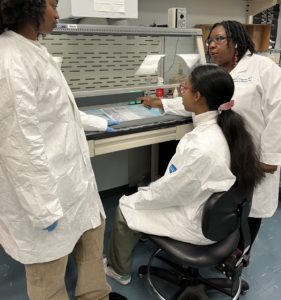 Q5: Which project would you consider to be your first breakthrough?
Q5: Which project would you consider to be your first breakthrough?
KR: There have been several memorable moments during my tenure as a research trainee and scientist. However, I think the first breakthrough that cultivated my interest in Neuroscience occurred during my graduate training at Howard University. The project encompassed several ultrastructural studies demonstrating synaptic interactions between protruder hypoglossal motoneurons with Substance P and the distribution of delta opioid receptor (DOR) or mu opioid receptor in processes with retrogradely labelled genioglossus muscle motoneurons. The data showed ultrastructural proof of a neurotransmitter or a receptor [i.e., substance P (SP) and DOR] directly synapsing upon a hypoglossal motoneuron retrogradely labelled from the genioglossus muscle, the major protruder of the tongue. These data contributed to our understanding of neural regulation of tongue movements which are critical to the etiology of diseases such as obstructive sleep apnea in which tongue plays an important role.
My graduate training taught me several technical skills, but also helped to hone personal skills of grit and perseverance in spite of adversities. There were moments during this time that helped to develop my character and desire to pursue a goal that had not been accomplished by anyone in my family. It afforded me the opportunity to be the first person in my family to earn a PhD. While the completion of the graduate project was a major accomplishment, the most memorable moment for me during that process was having my family see the fruit of all of their prayers and support by witnessing my defense to earn my doctoral degree.
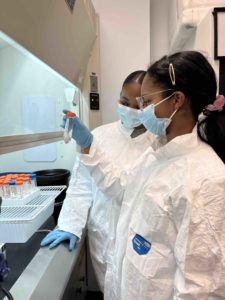 Q6: How did you correlate binge eating and drug addiction to Orexin/hypocretin?
Q6: How did you correlate binge eating and drug addiction to Orexin/hypocretin?
KR: This research area has been my major focus for several years. My interest in the orexin system began as a postdoctoral fellow in the laboratory of Dr Gary Aston Jones. The orexin system is a family of neuropeptides associated with several processes, including feeding, arousal, drug addiction, memory and pain. These fibres are distributed throughout the brain, allowing them to participate in various functions, including arousal, feeding and narcolepsy. At the time, many were interested in its possible involvement in drug reward since orexin cells projected to regions associated with the reward pathway.
My initial interest in the orexin system began by investigating if the VTA was a selective target for orexin neurons after protracted forced abstinence. Protracted forced abstinence is a Model to study brain mechanisms underlying the propensity for relapse. Past studies have indicated that animals that undergo protracted forced abstinence show altered hedonic processing. This occurs when animals with prior chronic drug exposure are drug conditioned several weeks after their initial drug withdrawal and express a greater preference for the drug rather than food. This behaviour is believed to mimic the behaviour of humans once drug dependence develops. Upon establishing my independent laboratory at Howard University, I searched the literature and learned that those with eating disorders (i.e., binge eating) are more likely to develop dependence to other addictive substances (i.e., stimulants, alcohol). I was curious about what would cause this co-occurrence. It had already been established that the orexin system was necessary for mediating feeding behaviour and drug addiction separately. But was it possible that the co-occurrence of both disorders was due to an alteration in the orexin system? This has been a question that members of my laboratory have been diligently working to answer.
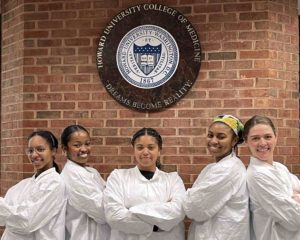
Q7: You are actively investing in undergraduate researchers and early-career scientists. How important is it for a student to find a supportive coordinator?
KR: Isolation and working in a silo are not good for success in research. Every person who has been successful in research can identify a mentor, teacher, or advisor who played an integral role in their success. These individuals provide information and many times the exposure that makes a significant impact on the student’s success. I call these people change agents or pathway directors because they can significantly impact the path of undergraduate researchers and early career scientists.
I am personally mandated to invest in young researchers because I can attest to the importance of having change agents during my own trajectory. Several people have sown great seeds in my life, and I have greatly benefited from what they instilled in me. It is my responsibility to do the same for early career researchers. I believe in the concept of sowing and reaping. The seeds sown into young researchers often manifest as successful “crops” (ie, confidence in abilities, knowledge, and scientific independence). These “crops” allow the young researcher to gain the skills needed for their development, and in turn, those early career researchers sow those skills and knowledge into their future mentees.
Undergraduate researchers and early career researchers should seek those who can help them grow, think circumspectly, be supported, and even be challenged so that they develop as scientists and as human beings. It is also important for young researchers to realise that they may need multiple mentors for different needs. The mentor who develops the young researcher’s technical skills may not be the same person who provides guidance for career development. I suggest that young researchers develop a list of what they think is needed and seek out people who can help accomplish those goals. I would encourage these young scientists to get out of their comfort zone and not be shy. They should take the initiative and introduce themselves to potential mentors. This is an opportunity to engage those who may be supportive and helpful for their career trajectory.
Q8: You joined the European Journal of Neuroscience as a Section Editor, focused on TBC. Why did you choose EJN?
KR: It is an honour to have been invited to be a section editor for the European Journal of Neuroscience (EJN). I chose to join the EJN editorial board because EJN is highly respected, and it presents the best of neuroscience research while also embracing our diverse scientific community. I have been welcomed by several fellow members of the editorial board, which produces an inclusive, scientific environment.
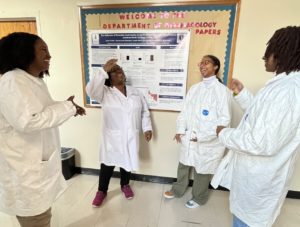 Q9: Given the publish or perish academic context, how can early-career researchers benefit from transparent peer-review publishing?
Q9: Given the publish or perish academic context, how can early-career researchers benefit from transparent peer-review publishing?
KR: One of the main difficulties as an early career researcher is being able to identify the “right” things to do. Everyone wants to be successful and is often taught that the way to be successful is through publishing consistently. While this idea is important, particularly for the tenure process, the “how” can be daunting. What should be expected during the review process? How should an author respond when revisions are given after a review? How do you balance addressing reviewers’ concerns while maintaining the clear purpose or scope of the study? These are some of the questions that an early career researcher may ask.
The transparent review helps authors, in particular early career researchers, who may have less experience with the full process to better understand the reviewer’s comments, the reply from the author, and the final decision of the editor. This process demystifies the review process and allows everyone the opportunity to view the editor’s decision about the article. Early career researchers benefit from this type of openness and transparency, and it provides them with the tools to understand how to have a paper accepted by a journal for publication. Another benefit for early career researchers is that transparent review may help resolve concerns about whether they will receive a fair and unbiased review. This is critical in building confidence as a researcher. It is anticipated that the tone and tenor of the review will be critical, but also fair since the comments and name of the reviewer will be publicly available.
About the European Journal of Neuroscience (EJN)
The European Journal of Neuroscience (EJN) is the official journal of FENS. Edited by Prof. John Foxe from the University of Rochester (USA) together with four Senior Editors Antoine Adamandis (CH), Paola Bovolenta (ES), Yoland Smith (USA), Vidita Vaidya (IN), EJN publishes original high-quality research articles and reviews in all domains of neuroscience. See the full Editorial Board on the EJN website.
EJN embraces Open Science, offers a rapid and easy submission process, fair and transparent peer review, no submission fees, page charges or formatting requirements, and ensures visibility with close to a million downloads per year (many being cited years after publication). EJN also serves fellow researchers by helping to support FENS activities and awards such as the FENS EJN Award, FENS EJN Young Investigator Prize and EJN Best Publication Award.
About the Federation of European Neuroscience Societies (FENS)
Founded in 1998, the Federation of European Neuroscience Societies is the main organisation for neuroscience in Europe. It currently represents 44 national and single-discipline neuroscience societies across 33 European countries and more than 22,000 member scientists. Discover FENS and subscribe to our biweekly News Alert, with information on our latest calls and activities.